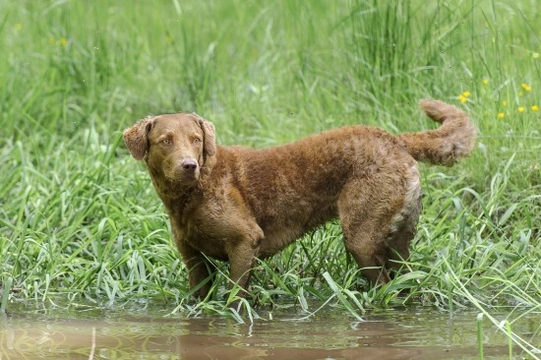Pets
Pets for studWanted petsBreedersAccessories & services
Knowledge hub
Support
Support & safety portal
Hereditary health and wellness of the Chesapeake Bay retriever
The Chesapeake Bay retriever is a retrieving dog breed that falls within the sporting, retrieving and gun dog groups, and which is also commonly referred to as the “Chessie.” The breed was developed during the 19th century in the Chesapeake Bay area of the USA, and was historically used to retrieve waterfowl for hunters. Today, they are most widely owned as family pets, and like most dogs of the retriever type, have made the transition to domestic life very well.
The size and conformation of the Chesapeake Bay retriever is similar to that of the Labrador retriever, and they share that breed’s open, friendly and outgoing temperament. The coat of the Chesapeake Bay retriever is one of its most defining characteristics, and the one that sets it apart from the Labrador retriever most effectively; the breed’s coats are double-layered and slightly curled in areas, and can be seen in colours ranging from liver to brown, with small areas of white spots permitted.
The Chesapeake Bay retriever is a medium sized dog, which stands up to 26” tall at the withers, and that can weigh up to 36kg. Males of the breed tend to be slightly larger than females, and the breed as a whole should be lithe and muscular without being stocky, long legged, fit and active.
If you have your heart set on owning a dog of the retriever type and the Chesapeake Bay retriever has caught your eye, it is of course important to do plenty of research into the breed before committing to a purchase. Part of this should involve looking into the general health and any hereditary health issues within the breed, and in this article we will examine the longevity, genetic diversity and health of the Chesapeake Bay retriever in more detail. Read on to learn more.
Chesapeake Bay retriever longevity
There is quite a lot of variance in terms of the statistical longevity of the breed as a whole, with a UK survey placing the breed’s median lifespan at 10.75 years, while an American survey placed the breed at 9.4 years. To further complicate estimates of the average, one in four dogs of the breed that were surveyed lived beyond 13 years, while one in five died prior to the age of five.
Hereditary health problems often account for juvenile deaths and abnormally shortened lifespans within pedigree dog breeds, and this can go some way towards explaining the significant degree of variance found across the breed as a whole.
Genetic diversity and conformation issues within the breed
The coefficient of inbreeding statistic across the breed as a whole is 7.4%, which is slightly higher than the 6.25% or below that is considered to be the ideal, but not high enough in itself to pose a significant risk of inbred health problems within the breed.
Ideally, breeding stock should possess a coefficient of inbreeding statistic of below 7.4% in order to be considered as ideal.
The deep-chested conformation of the Chesapeake Bay retriever places the breed at risk of developing bloat or gastric dilation volvulus, which is an acute and serious condition leading to a build-up of stomach gas, which ultimately may lead to the stomach twisting. All owners of dogs of the breed should be aware of the symptoms of this condition, and be prepared to act quickly if it is suspected.
Health testing for the Chesapeake Bay retriever
The British Veterinary Association recommends health testing for dogs of the breed prior to breeding, in order to improve the hereditary health of the breed as a whole, and reduce the incidence rate of genetically inherited flaws and defects. Tests are advised for the following conditions:
- Hereditary cataracts, and also progressive retinal atrophy are present within the breed, and parent dogs should be tested prior to breeding.
- Hip dysplasia is also somewhat prevalent, with the breed’s mean hip score being 12.9. Breeding stock should receive a hip score lower than this to be classed as a good choice for breeding.
- Elbow dysplasia can also be tested, with the ideal score being zero.
- Exercise-induced collapse, or EIC, is another hereditary condition that can be identified by means of DNA testing.
- Degenerative myelopathy, which affects the spinal cord and can cause hind limb paralysis, can also be diagnosed by means of DNA testing.
Other health concerns
A few other conditions are also recognised within the Chesapeake Bay retrieve breed, but for which no current pre-breeding testing is available. These include:
- Epilepsy.
- Shoulder osteochondrosis, mainly diagnosed in male dogs. This leads to abnormal development of the shoulder bones and cartilage, causing pain and eventually, arthritis.
- Von Willebrand’s disease, a blood clotting disorder.
- Panosteitis, another bone disorder.
- Various types of cancer, with melanomas of the skin being one in particular that is found to occur more commonly within the Chesapeake Bay retriever breed, according to American health data.



